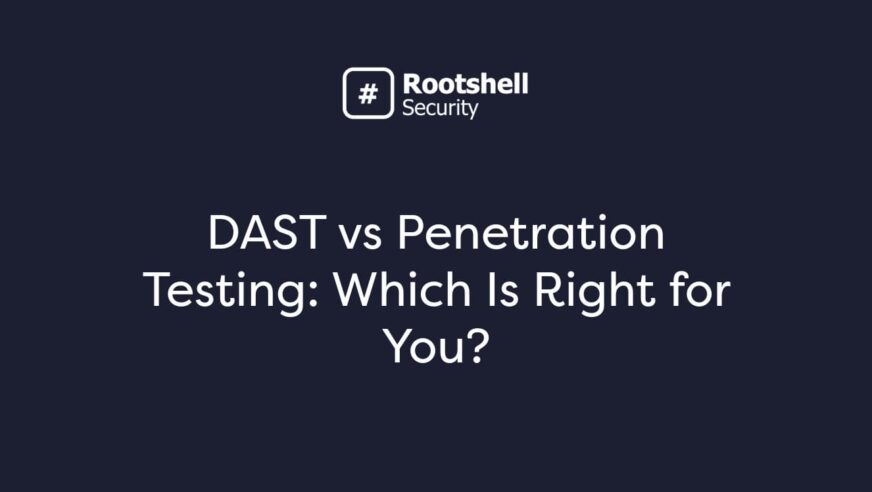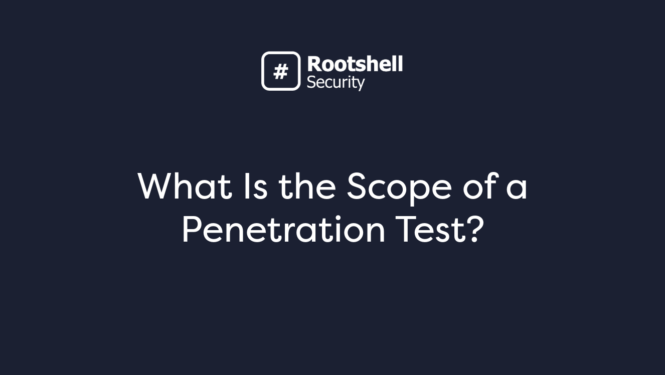Web applications form the backbone of most business operations, but with that reliance comes exposure to cyber threats. Security testing methods such as Dynamic Application Security Testing (DAST) and penetration testing are used to identify and address weaknesses before attackers can exploit them. Although these two approaches share some similarities, they are not interchangeable. Each has its own methodology, scope, and purpose.
This article explains how penetration testing is conducted, how DAST works, the benefits and drawbacks of both methods, and the situations in which each is most suitable. A structured comparison will help you understand where these approaches align and where they differ, so you can make informed decisions about securing your applications and systems.
What Is DAST?
Dynamic Application Security Testing, commonly known as DAST, is a method for evaluating the security of applications while they are active and running. Unlike static testing, which examines source code without execution, DAST interacts with a live application to detect vulnerabilities that can be exploited in real-world conditions.
It is generally used for web applications and focuses on how the software behaves under different inputs and interactions. By testing from the outside in, DAST provides insight into how attackers may attempt to exploit an application once it is deployed and accessible to users.
One of the main advantages of DAST is that it simulates attacks exactly as an external threat actor would, providing a realistic view of the application’s security posture. It is particularly useful for web applications and APIs, where the majority of attacks target exposed interfaces rather than internal code.
How Does DAST Work?
DAST operates by crawling an application in much the same way as an automated user or bot might. It identifies entry points, such as forms, cookies, and query parameters, and then attempts to manipulate these inputs to find flaws.
Common testing activities include:
- Sending malicious payloads to expose input validation issues
- Detecting SQL injection or cross-site scripting vulnerabilities
- Analysing authentication and session management weaknesses
- Monitoring error messages and server responses for unintended disclosures
Because DAST requires an application to be running, it can assess both in-house developed systems and third-party applications. The results provide insights into vulnerabilities that only appear during execution, such as runtime configuration errors or improper handling of user data.
Pros and Cons of DAST
Advantages of DAST:
- Tests applications in real-world conditions, identifying flaws that only surface during execution
- Can be automated, making it suitable for regular use during development cycles
- Does not require access to source code, allowing third-party applications to be assessed
Limitations of DAST:
- May produce false positives that require manual validation
- Limited visibility into the underlying source code, meaning certain logic flaws may be missed
- It can be time-consuming if the application is complex or has a large attack surface
Common Tools Used in DAST
Several tools are used for DAST, both open source and commercial. Examples include:
OWASP ZAP (Zed Attack Proxy): A popular open-source option for scanning web applications.
Burp Suite: Provides a suite of tools for automated scanning and manual testing.
AppScan: IBM’s commercial tool with advanced reporting and compliance features.
Netsparker (Invicti): Known for automation and accuracy in detecting injection flaws.
The choice of tool often depends on the application’s complexity, the team’s budget, and the desired level of reporting.
What Is Penetration Testing?
Penetration testing is a security assessment method where trained testers mimic the techniques of hackers to find and exploit weaknesses. Unlike automated scanning, it involves human decision-making, creativity, and adaptability.
The objective is not only to discover vulnerabilities but also to assess their real-world impact. For instance, a pen tester may uncover a weakness in a login system and attempt to use it as a stepping stone to compromise sensitive data.
How Is a Typical Pen Test Carried Out?
Penetration testing follows a structured methodology to identify and assess security weaknesses in an organization’s systems. The process typically involves multiple stages, from planning and reconnaissance to exploitation, reporting, and optional retesting, ensuring a thorough evaluation of security.
1.Planning and Reconnaissance
Objective Setting: Define the scope, goals, and systems to be tested. Clear objectives ensure the test aligns with business priorities and compliance requirements.
Information Gathering: Collect publicly available information about the target, such as domain names, network ranges, and employee details. This helps identify potential entry points for an attack.
Threat Modelling: Identify potential attack vectors and prioritise which areas are most important. This guides the testing process and ensures high-risk areas receive focused attention.
2. Scanning and Vulnerability Analysis
Network Scanning: Use tools to detect live hosts, open ports, and running services. This maps the attack surface and highlights potential vulnerabilities.
Vulnerability Scanning: Identify known vulnerabilities in systems and applications using automated tools. This step helps focus exploitation efforts on weaknesses that could be exploited in real attacks.
3.Exploitation
Attempt to exploit identified vulnerabilities to determine the level of risk they pose. Testing real-world attack scenarios is conducted safely to avoid disrupting operations while providing insight into potential impacts.
4.Post-Exploitation and Privilege Escalation
Analyse the extent of access gained and attempt to escalate privileges where possible. This evaluates the potential damage an attacker could cause and highlights critical vulnerabilities.
5.Reporting
Document all findings, including discovered vulnerabilities, exploitation methods, and potential impacts in a penetration test report. Provide actionable remediation recommendations to help organizations strengthen their security.
6. Retesting (Optional)
After fixes are applied, a follow-up test can be conducted to ensure vulnerabilities have been properly addressed. Retesting validates that corrective measures are effective and sustainable.
Types of Penetration Tests
The different types of Penetration testing can be categorised by scope and methodology:
Black Box Testing
In black box testing, penetration testers have no prior knowledge of the system, network, or application they are assessing. This approach simulates the perspective of an external attacker attempting to breach an organization’s security without insider information. The goal is to evaluate how well the system can withstand attacks from unknown sources and to identify vulnerabilities that could be exploited in real-world scenarios.
White Box Testing
White box testing gives testers full access to system information, including source code, architecture diagrams, and configuration details. With this level of transparency, testers can perform a more in-depth and thorough analysis, identifying subtle vulnerabilities that might go undetected in black box tests. White box testing is especially useful for assessing complex applications and internal security controls.
Grey Box Testing
Grey box testing is a hybrid approach, where testers have partial knowledge of the system. This might include limited access to source code or some understanding of internal architecture. Grey box testing balances the realism of black box attacks with the efficiency and thoroughness of white box testing, making it effective for identifying critical vulnerabilities while maintaining a practical testing scope.
External Testing
External penetration testing focuses specifically on internet-facing systems and applications. Testers simulate attacks from outside the organization to determine whether attackers could gain access to sensitive data, exploit web applications, or breach network perimeters. This type of testing is crucial for organizations that rely on public-facing services.
Internal Testing
Internal penetration testing assumes the role of a malicious insider or an attacker who has gained access to the internal network. Testers can evaluate how well security controls prevent privilege escalation, and access to sensitive systems from within the organization. This approach highlights risks that external testing alone might miss.
Targeted Testing
Targeted testing is performed with full transparency between the penetration testers and the organization’s security team. Often used for training or red team exercises, this approach allows both parties to collaborate closely while testing real-world attack scenarios. Targeted testing provides valuable insights into how quickly security teams can detect and respond to threats.
Pros and Cons of Penetration Testing
Advantages of Pen Testing:
- Provides a realistic assessment of how attackers could compromise systems
- Human-led approach can uncover complex, context-specific vulnerabilities missed by automated tools
- Helps organizations meet compliance requirements in industries where testing is mandated
Limitations of Pen Testing:
- Resource-intensive, often requiring skilled professionals and substantial preparation
- Only provides a snapshot in time, meaning new vulnerabilities may appear after the test
- Can be costly compared to automated scanning methods
DAST vs Penetration Testing: A Side-by-Side Comparison
To understand how DAST and penetration testing differ, it is helpful to look at a side-by-side comparison. While both aim to uncover vulnerabilities, they take different approaches, focus on distinct areas, and offer unique advantages and limitations. The table below highlights the main differences between these two security testing methods.
Aspect | DAST | Penetration Testing |
Method | Automated scanning of running applications | Human-led simulated attack scenarios |
Scope | Focuses on web applications | Can cover networks, applications, and infrastructure |
Depth | Identifies runtime flaws but has limited code insight | Explores vulnerabilities in depth with manual testing |
Frequency | Can be run regularly, even integrated into CI/CD | Conducted periodically, often annually or biannually |
Cost | Generally lower due to automation | Higher, due to human expertise and the time required |
False Positives | More likely, requiring validation | Less frequent, but still possible |
Compliance | Supports ongoing monitoring | Often required for certifications and audits |
Skills Needed | Security knowledge to interpret reports | Experienced testers with broad technical expertise |
Which Security Testing Method Should You Choose?
DAST and penetration testing should not be seen as competing methods but as complementary. DAST is suitable for ongoing assessment throughout the development lifecycle, providing feedback on security. It is particularly valuable for organizations looking for regular visibility into web application risks without needing source code access.
Penetration testing, on the other hand, is indispensable when an in-depth assessment is required. It provides a real-world view of how vulnerabilities could be chained together to achieve broader compromise. It also helps organizations meet regulatory obligations and gain assurance at executive level.
In practice, most mature security programmes adopt both. DAST is integrated into development pipelines for continuous visibility, while penetration testing is scheduled periodically to provide a thorough, human-driven assessment. This layered approach helps balance cost, coverage, and accuracy.
Strengthen Your Applications with Rootshell Security
With more organizations automating large portions of their security testing, choosing the right approach has never been more important. Both DAST and penetration testing provide value, but the right fit depends on your specific requirements and security objectives.
Rootshell Security delivers tailored security solutions that protect your most important assets including applications, networks, infrastructure, endpoints, and cloud environments.
Our consultants hold CREST and CHECK certifications and have delivered testing for clients across finance, healthcare, and government
Combining proven expertise in penetration testing, DAST, Rootshell Security helps organizations identify vulnerabilities, reduce risk, and build long-term security maturity. Our consultants bring deep technical knowledge, trusted advisory support, and round-the-clock expertise to help you stay ahead of attackers.
If you would like to learn more about Rootshell Security’s services, book a free consultation with our team to see which approach fits your security strategy and get in touch with our team today.
Frequently Asked Questions
1. What is the main difference between DAST and penetration testing?
DAST is an automated approach that tests live applications from an external perspective, while penetration testing is a human-led assessment that simulates real-world attacks to uncover vulnerabilities.
2. Can DAST replace penetration testing?
No. DAST is best for regular, automated checks during development, whereas penetration testing provides an in-depth evaluation of complex security weaknesses that require human expertise.
3. Which types of applications benefit most from DAST?
Web applications and APIs benefit most, as DAST tests the runtime behaviour and exposed interfaces that attackers are likely to target.
4. How often should penetration testing be performed?
Typically, penetration tests are conducted periodically, such as annually or biannually, or after major system updates to identify new vulnerabilities.
5. Are DAST and penetration testing complementary?
Yes. Many organizations use DAST for continuous monitoring and penetration testing for deep, periodic security assessments. Together, they provide layered protection.
6. Do I need access to source code for DAST?
No. DAST works from the outside in, testing the application as a running system, which means it can be applied to third-party applications without source code access.
7. What skills are required for penetration testing?
Penetration testing requires experienced security professionals with knowledge of networks, applications, exploitation techniques, and threat modelling.
8. Can DAST detect all types of vulnerabilities?
DAST is effective at finding runtime and input-related vulnerabilities, but it may miss certain logic flaws or deeper code-level issues that penetration testing can uncover.
9. How do I choose between DAST and penetration testing?
Choose DAST for ongoing, automated assessment during development, and penetration testing when you need a thorough, human-driven evaluation or to meet compliance requirements.
10. How do DAST and penetration testing fit into a Continuous Threat Exposure Management (CTEM) programme?
DAST provides continuous, automated checks of live applications, helping uncover exposures quickly and often. Penetration testing adds depth by showing how those issues could be exploited in real-world scenarios. Together, they give CTEM programmes both regular visibility and detailed validation, ensuring organizations can prioritise and reduce their most critical risks.



